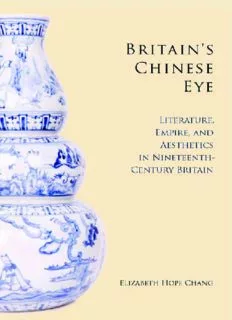
Britain's Chinese Eye: Literature, Empire, and Aesthetics in Nineteenth-Century Britain PDF
Preview Britain's Chinese Eye: Literature, Empire, and Aesthetics in Nineteenth-Century Britain
Britain’s Chinese eye Britain’s Chinese Ey e literature, empire, and aesthetics in nineteenth-century britain Elizabeth Hope Chang stanford university press Stanford, California 2010 stanford University Press stanford, California ©2010 by the Board of trustees of the Leland stanford Junior University all rights reserved this book has been published with the assistance of the Paul Mellon Centre for studies in British art. Parts of Chapter 2 were first published in Nineteenth Century Studies 19 (2005): 17–34. reprinted with permission no part of this book may be reproduced or transmitted in any form or by any means, electronic or mechanical, including photocopying and recording, or in any information storage or retrieval system without the prior written permission of stanford University Press. Library of Congress Cataloging-in-Publication Data Chang, elizabeth hope. Britain’s Chinese eye : literature, empire, and aesthetics in nineteenth-century Britain / elizabeth hope Chang. p. cm. includes bibliographical references and index. isbn 978-0-8047-5945-8 (cloth : alk. paper) 1. Great Britain—Civilization—Chinese influences. 2. Great Britain—Civilization—19th century. 3. english literature—19th century—history and criticism. 4. aesthetics, British—19th century. 5. China—in literature. 6. China—in art. i. title. da533.c46 2010 303.48'24105109034—dc22 2009034668 Printed in the United states of america on acid-free, archival-quality paper typeset at stanford University Press in 10/13.5 Galliard To my grandmothers Acknowledgments it is a pleasure to be able to thank the many people who have helped see this book into print. their assistance has added immeasurably to the value of this work; any faults that remain are mine alone. the University of California at Berkeley introduced me to wonderful scholars (some now dispersed to other places) who helped start this proj- ect in the right direction and, more important, taught me how to ask the questions i needed to keep it going on my own: Celeste Langan, sharon Marcus, Colleen Lye, Catherine Gallagher, and Lydia Liu. Mai-Lin Cheng and asali solomon remain trusted sounding-boards and true friends. i also thank the University of California for a Dissertation-year fellowship and the townsend Center for the humanities for allowing me to participate as a year-long fellow and showing me what interdisciplinary conversation could look like. at the University of Missouri, the english Department as a whole, and especially my colleagues in eighteenth- and nineteenth-century studies— noah heringman, George Justice, Devoney Looser, and nancy West— have offered support, advice, and friendship in equal measure. sam Cohen, Joanna hearne, and Donna strickland read every page of this book and made every page of it better. the students, both graduate and undergradu- ate, have helped me tremendously both by taking generous interest in my work and by sharing their interests with me. the University of Missouri research Board and research Council supported a year’s leave and a sum- mer’s visit to London archives, respectively; both were indispensable to the progress of this manuscript. viii Acknowledgments For their comments on and support of my work, i wish to thank the members of the Dickens Project, ross Forman, Dane Kennedy, Douglas Kerr, Julia Kuehn, Peter Logan, teresa Mangum, erika rappaport, and Philip stern. David hanson published an earlier and partial version of Chapter 2 in Nineteenth-Century Studies and gave valuable editorial feed- back. i also thank the library staffs who have helped me acquire the neces- sary materials for this study, in particular all the library staff at the Uni- versity of Missouri, as well as the Bancroft rare Book Library, the British Library, the Wellcome Library, the Lindley Library of the royal horticul- tural society, and the Library and archives at the royal Botanic Gardens, Kew. at stanford University Press, i want to thank especially emily-Jane Co- hen, who shepherded this book through its long development process, and sarah Crane newman, attentive to every detail. i also want to thank the anonymous readers of the manuscript whose suggestions changed this book in uniformly good ways. My family has remained ever patient with the demands of this project. i want to thank all of them, especially Claire and ed stiepleman, kindest of in-laws; Lily shih, Witt Monts, Gabriel Monts, and serena Monts, best of cousins; and of course my parents, Margaret and raymond Chang, who showed me how to write and to teach long before i realized that i would want to do both of those things. i have since realized both how hard and how wonderful it is to follow their shining examples. Most of all i must thank my children, isaac, ezra, and Jacob, and my husband, Peter, for love and companionship beyond the bounds of words. Contents introduction 1 1. Garden 23 sir William Chambers and the Dissertation on Oriental Gardening, 28. the Macartney Mission of 1793 and the Qing imperial Gardens, 37. robert Fortune as horticultural spy in racial Disguise, 56. 2. Plate 71 romantic satires on Blue and White China, 75. the Willow Pattern and George Meredith’s The Egoist, 88. Whistler and rossetti as Collectors of Blue and White Porcelain, 97. 3. Display Case and Den 111 exhibiting China in Victorian London, 115. Display Cases and Opium Dens in The Mystery of Edwin Drood, 125. Edwin Drood’s inheritors, 133. 4. Photograph 141 Felice Beato and the second Opium War, 146. through China with John thomson’s Camera, 152. “a truthful impression of the Country”: isabella Bird, 163. Conclusion 179 Notes 187 Works Cited 219 Index 229
Description: